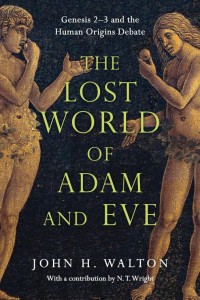Review: The Lost World of Adam and Eve
Note: The Lost World of Adam and Eve; Genesis 2-3 and the Human Origins Debate is by John Walton (IVP, 2015), 255 pages. John Walton is Professor of Old Testament at Wheaton College and Graduate School. This review is copyright © 2015 Dr. Norman L. Geisler. All rights reserved.
Being a graduate of both Wheaton schools (B.A., M.A.), I was especially interested in Professor Walton’s book. And having been a founding member of the International Council on Biblical Inerrancy and a co-framer of its statements, I was further intrigued with one of the recommendations of the book by Skye Jethal which said, “We who are committed to the authority of Scripture believe it is inerrant in all that it affirms. Determining what it’s affirming is the tricky part, and that is precisely what John Walton helps us discern” (inside front cover).
The Author’s Summary of His Book
The author did his readers a service by summarizing his own thoughts near the end of the book: “Throughout this book, I have offered biblical support for the possibility that humanity was created en masse in Genesis 1, that the presence of other people is assumed in Genesis 4 and that Genesis 2 does not intend to offer an account of fully de novo material origins. If the evidence should prove persuasive that (1) no theology is dependent on or derive from the traditional assertions of the de novo creation of Adam and Eve as the first two humans, who were alone in the world and the direct progenitors of the entire human race, and if (2) sound, faithful exegetical offers plausible alternative interpretations, then we would have no reason to be committed to those traditional beliefs as the only acceptable interpretation. In such a case, inerrancy and the text would not demand them from us, and we would hold them by our preference” (204).
Walton continues, “If it turns out (as I believe it does) that science offers evidence to the contrary, we are free to consider its claims. In other words, if neither exegesis nor theology intractably demands those conclusions that argue against the modern scientific consensus premised on common descent, we have no compelling reason to contest the science” (204).
His consolation prize is that “We can contend that Adam and Eve are theologically and historically significant even if they were not the first humans. We can contend that Adam and Eve are appropriately positioned as fountainheads of humanity even if we are not all their direct descendants. We can contend that humanity has a distinct place in the created order, unique among species, even if Adam and Eve are not de novo creations” (206).
Walton Offers Four Practical Reasons for His Position
Creation Care: God has appointed us to be vice-regents to care for this world. “We have the responsibility to maintain the space that is ultimately sacred and ultimately his” (207).
Ministry: We need to encourage those in scientific fields in the church “not by making them choose (Bible or science) but by charting a path of convergence and compatibility” (208).
Evangelism: “…they [unbelievers] have heard that to accept Christianity means to abandon their brains” or “to accept Christ means to reject certain scientific conclusions—a step they cannot take” or “no evolution model is acceptable by a Christian” (208-209).
Considering the Future: “They [our young people] have heard that their revered pastors tell them that people who believe in evolution cannot be Christians” (209). This is why many young people leave the church.
A Summary of the Crucial Points of Walton’s Book
A summary of the critical points in Walton’s thesis is necessary to evaluate his book properly. There are many subsidiary issues, but the main pillars of his view are:
1. The Bible does not teach that a literal historical Adam and Eve are Progenitors of the Human Race
2. The scientific evidence supports the belief in macro evolution.
3. Holding both 1 and 2 is not contrary to the doctrine of inerrancy.
4. An acceptance of 1-3 is crucial to fulfilling the mission and proper growth of the Church.
It is noteworthy that the first two of these points must be true to validate Walton’s conclusion in the third point. If either one is false, then his overall thesis fails, even if the other one is true.
First we will state each point in Walton’s own words, and then we will evaluate it from a biblical and evidential point of view.
1. The Bible does not teach that a literal historical Adam and Eve are Progenitors of the Human Race.
This point is dependent on a previous one which Walton grants, namely, that there was a literal historical Adam and Eve. However, he has two significant Caveats.
First, he confessed, “I do affirm the historicity of Adam. But I do not consider interpreters who are trying to be faithful to Scripture to be denying inerrancy if they arrive at a different conclusion” (202). Apparently, then, any sincere exegete could deny the historicity of Adam and still be consistent with inerrancy? How about those who deny the historicity of Christ’s resurrection?
Second, “…perhaps what Genesis is telling us is that God chose one pair from the rest of early hominids for a special, strange, demanding vocation. This pair (call them Adam and Eve if you like) were to be the representatives of the whole human race, the ones in whom God’s purposes to make the whole world a place of delight and joy and order…” (177- 178). So, to establish this first point we must show that (a) the Bible teaches us that there was a literal couple, commonly called Adam and Eve, (b) who were the progenitors of the entire human race. Let’s take them in order:
(a) There was a literal first man called Adam (who had a wife called Eve)
Walton claims that “Current scientific understanding maintains that there was no first human being because humanity is the result of an evolving population. The evidence of genetics also points to the idea that the genetic diversity that exists in humanity today cannot be traced back to two individuals—a single pair—but that such diversity requires a genetic source population of thousands” (183). He sees that as no problem since “Genesis 1 and 2 raised the possibility that the Adam and Eve account in Genesis 2 could have come after an en masse creation of humanity in Genesis 1, though Adam and Eve should be considered as having been included in that group” (183).
However, strong evidence for the fact that Adam was literally the first human, being made in God’s image (Gen. 1:27), is found both in the Old and New Testaments, as well as in the history of Judaism and the Christian Church. Consider first the biblical evidence.
The cumulative biblical evidence for a literal Adam and Eve is very strong. (1) First of all, Genesis presents Adam and Eve as actual persons and even narrates events in their lives (their creation, naming animals, marriage, fall, and their expulsion from the Garden). (2) Adam is presented as a literal being who came “from dust” (Gen. 2:7) and will return “to dust” (Gen. 3:19). (3) Further, Adam and Eve gave birth to real children who also had real children (Gen. 4-5) and had “other sons and daughters” (Gen. 5:4). (4) There existed real rivers still known (Euphrates and Tigris, Gen. 2:14). (5) Eve is the name of the first woman, and it notes her temptation by the devil (1 Tim. 2:14; 2 Cor. 11:3). (6) Furthermore, their sons Cain and Abel are listed with other historical persons in Heb. 11:4). (7) Also, the phrase “This is the history of” (Gen. 2:4) is used of Adam (5:1) and later historical persons, such as Ishmael (25:12), Isaac (25:19), Esau (36:1), and Jacob (37:2). (8) Also, Paul affirmed that “Adam was first formed, and then Eve” (in 1 Tim. 2:13-14). (9) In addition, the OT puts Adam at the beginning of the genealogy of real people (1 Chron. 1:1). (Even Walton acknowledges this as an evidence of Adam’s historicity, saying “It would not be surprising if Israelites in the Old Testament and New Testament times believed that Adam was the first human being” (188). He adds, “Consequently there would be no precedent for thinking of the biblical genealogies differently from others in the ancient world). By putting Adam in ancestor lists, the authors of Scripture are treating him as a historical person” (102)]. (10) Also, Hosea 6:7 names “Adam” as the first person who broke God’s covenant. (11) And the NT places Adam at the beginning of Jesus’ genealogy of real people (Luke 3:38). (12) Indeed, Jesus referred to Adam and Eve as the first literal male and female united by God as the basis for a literal marriage (Matt. 19:4-5). (13) Adam is called “the first man Adam [who] became a living being” (1 Cor. 15:45). (14) Paul affirms that “Adam was formed first; then Eve” (1 Tim. 2:13 cf. Gen. 2:7, 22). (15) Adam, who is compared to another literal human being, Christ who is called “the last Adam” (ibid.). (16) And the apostle Paul declared that literal death came upon all men because of Adam’s sin (Rom. 5:12-14). (17) Adam is compared with the literal person of Christ (in 1 Cor. 15:22).
Eve was a Co-Progenitor of the Human Race with Adam
(1) Eve was also a literal person who, with Adam, were physical progenitors of the human race. For “Adam named his wife Eve, because she would become the mother of all living” (Gen. 3:20 NIV). Even translated in the present as “She is the mother of all living” (ESV), her name (hawwa, living or life-giver) “signifies that the woman became a pledge in the continuation of the race, in spite of the curse.” Allen Ross (Creation and Blessing, 148). Her name also reflects the earlier prediction that the “seed of the woman” (Gen. 3:15) would bring life and salvation into the world through her “seed” (offspring). Contrary to Walton (187), whatever else it may imply it does not exclude being the genetic progenitor. Likewise, a similar phrase “father of all” used of Jubal (Gen 4:21) implies a genetic progenitor since he was the genetic father of all “those [humans] who played” the harp; he was not the father of the organ.
(2) Further, God made them “male and female” (Gen. 1:27). The woman along with the man were created in God’s image. Both were physical beings.
(3) God made Eve from “one of his [Adam’s] ribs” (Gen. 2:21). This implies a genetic similarity with Adam.
(4) As Paul put it, “For Adam was first formed, then Eve” (1 Tim. 2:11-14). Both were made by God, and each was a physical match for the other. And Paul based a theological teaching upon this God-ordained order.
(5) The apostle adds, “woman was made from man” (1 Cor. 11:12). Here again these are not, as Walton contends, incidental references on which the apostle bases no teaching.
Was a Historical Adam Created De Novo?
President Philip Ryken of Wheaton College presented six significant arguments for a historical Adam: 1. It explains humanity’s sinfulness; 2. It accounts for the presence of evil in the world; 3. It clarifies the biblical position on sexual identity and family relationships; 4. It assures us that we are justified before God; 5. It advances the missionary work of the church; 6. It secures our hope in the resurrection of the body and life everlasting (203). He added, “We cannot understand the world of our faith without a real, historical Adam.” But Wheaton Professor Walton summarily dismisses his arguments, claiming that “some of these are a matter of interpretation” and “even if we accept without question all these points, we could still maintain that no theology is built on the scientific implications commonly associated with Adam and Eve: that they must (theologically speaking!) be created de novo, as the only people at the beginning of humanity and those from whom we are all descended” (203-204).
Since we have already given the evidence that Adam and Eve were the primal parents of the human race, let me speak briefly of de novo creation. Walton defines “de novo” as “direct material act of God distinct from any predecessor, and using no biological process” (241).
In response, the literal historical-grammatical interpretation endorsed by ICBI (CSBI, Article 18) demands a de novo creation of God because: (1) Adam was created from “dust” [not from lower animals], and he will return to dust (Gen. 2:7; 3:19; Job 34:15; Eccl. 3:20); (2) Eve was made from Adam’s “rib” (Gen. 2:21); (3) God “created” (not developed through evolution) every living things (Gen. 1:21); (4) All acts of “creation” (bara) in Genesis 1 (1:1; 1:21; 1:27) resulted from God “speaking” and it occurred. Paul describes the creation of light as ex nihilo (out of nothing), “Let light shine out of darkness” (2 Cor. 4:6). Darkness does not evolve into light; rather, lightning strikes it from the outside; (5) Every form of life “produced its own kind” (it did not evolve into another kind); (6) Humans were made in God’s image, “male and female” which involves bodies (Gen. 1:27); (7) Humans could speak and name things from the beginning (Gen. 2:19-20; 3:3, 10); (8) Humans had moral capacity and responsibility from the beginning (Gen. 2:16-17); (9) Humans had God-consciousness from the start (Gen. 3:1-13). (9) Jesus affirmed this was all “from the beginning” (Matt. 19:4) from the “beginning of world” (Matt. 24:21). The only normal, literal interpretation of these verses is that the creation of Adam was de novo.
False Distinction between Authoritative Affirmation and Incidental Reference
In order to justify his claim that certain biblical references to Adam have no authority (181, 183), Walton makes a false distinction between what the Bible teaches authoritatively and what it mere refers to incidentally (see 201, 206, 208). For example, references to Adam in a genealogy are merely incidental (188-189), as is the mention of a person believing in his heart. Also, the references to human origins fall into this category God (186).
However, this distinction involves a denial of inerrancy for several reasons. First, the Bible is inspired on whatever topic it touches, as well as those it teaches. Second, Whatever the Bible affirms (on any topic) is inspired. For whatever, the human author of Scripture affirms, God affirms. The Bible is a co-authored book. So, whatever the Bible says is so, God says is true too. So, if the Bible affirms Adam is the genealogical progenitor of the human race, then it is true that Adam is the genetic progenitor of the race. To deny this is to deny the full inerrancy of the Bible for a form of limited inerrancy.
The ICBI doctrinal statements make this point clear in the following references: “We affirm that the whole of Scripture and all its parts, down to the very words of the original, were given by divine inspiration. We deny that the inspiration of Scripture can rightly be affirmed of the whole without the parts, or of some parts but not the whole” (CSBI, Article 6). Further, “We affirm that inspiration…guaranteed true and trustworthy utterances on all matters of which the biblical authors were move to speak and write” (CSBI, Article 9). What is more, “We deny that biblical infallibility and inerrancy are limited to spiritual, religious or redemptive themes, exclusive of assertions in the fields of history and science” (CSBI, Article 12). The official ICBI Commentary on this point declares clearly that “the Bible does have something to say about the origin of the earth, about the advent of man, about creation, and about such matters that have scientific import…” (CCSBI, Article 12).
Adaptation versus Accommodation
In so-called “incidental” references, Walton wrongly assumes an accommodation view of revelation wherein God accommodates to the incidental beliefs of the author (201) which are not true. But he never affirms anything that is false. This view compromises the inerrancy of Scripture by claiming that human authors of the Bible sometimes accommodate to error, when they are writing. Actually, they adapt to human finitude so that the common reader can understand them, but they never accommodate to error. For example, a parent may adapt to the finitude of a small child by saying “babies come from their mother’s tummy.” But they should not accommodate to error by claiming that “storks bring the babies.”
Walton’s illustration is the biblical reference to the “heart.” He wrote, “To return to the example of thinking with the heart, one could not necessarily claim that inerrancy demands that we believe that the heart is physically the center of the intellect. Inerrancy pertains to that which the text affirms, and we have concluded that physiology is not affirmed by the text: instead ancient views of physiology were accommodated” (201). The error here is child-like. The word “heart (Gk: kardia) as used of the inner human being is not a reference to a physical organ. It refers to the whole inner man or person. As every interpreter should know, the meaning of a term is discovered by its context. And when the Bible speaks of the heart thinking, believing, or living (Mt. 22:37; Rom. 10:9) it is not referring to the blood pump in the middle of our chest. In short, what the heart (as the whole inner person) should believe is not an incidental accommodated truth; it is a divinely authoritative one.
Professor Walton misconstrues John Calvin on this very point, citing him as though he believed in accommodation to error, when all Calvin was approving was the Bible adapting to our finitude and speaking in common language (202). What Calvin said was, “Moses wrote in a popular style things which, without instruction, all ordinary persons, endued with common sense, are able to understand…” (Ibid.).
Walton’s Reinterpretation of Biblical Text Support to His Evolutionary View
Acts 17:26 says explicitly that God “made from one man every nation of mankind to live on all the face of the earth….” In addition, not only was Adam the first human being (with Eve his wife), but they became the progenitors of the whole human race. He believes that this echoes Genesis 10:32 which declares that “these are the sons of Noah who descended from Adam, and from these the nations spread abroad on the earth after the flood” (Gen. 5:2, 32).
Further, Walton argues that Acts 17:26 is referring to Noah, not Adam, saying of Genesis 10:32 that “This is the only verse in the Old Testament that talks about the origin of the nations as a group and is therefore arguably the verse to which Paul refers [in Acts 17:26]. If that is so, the ‘one’ that he refers to is Noah, not Adam” (187). He further insists that Paul is referring to origin of “nations” as an ethnic group and not to individual genetically.
A Response to Walton’s View on Human Origins
However, there is multiple evidence that Paul is including all individuals (of which nations are made). First, the word “made” (epoiasen) is used in this same context (Acts 17:24) of God making the world (cosmos). Second, it is used elsewhere in Acts 4:24 of “the Sovereign Lord, who made heaven and earth and the sea and everything in them” (cf. Acts 7:49-50). Third, it urges all men to seek Him (v. 27) and claims that all humans exist only “in Him we live and move and have our being” (v. 28) and, therefore should seek Him (v. 29). All this implies a genetic view of human beings who are connected to each other and to this one God by creation. Fourth, Paul elsewhere speaks of “the condemnation of all men” in Adam (Rom. 5:12, 13, 17), showing their unity and origin in him. In view of the context, to reduce this text to God forming or organizing nations is to reveal more of a Platonic influence (where the Demiurgos orders the eternal chaos into a cosmos but does not bring it into being). As St. Augustine put it, we are born “with a propensity to sin and a necessity to die” (City of God 14.1).
So, all men spring from Adam genetically. We were “in Adam” (1 Cor. 15:22 cf. Rom. 5:12). Contrary to Walton, at birth we inherit the “propensity to sin.” Since we all come from Adam by a natural process, we share in his fall and inherit his fallen nature. Walton’s first point is without scriptural support. Considering the lack of evidence for his denial that there was a literal physical Adam from which the whole human race sprang, one wonders why Walton has pursued this issue so strongly. The motivation could lie in his second point. If macro-evolution is correct and there was no one first parent from which we all sprang, then he either has to (a) discard his belief in the Bible or (b) reinterpret the Bible in view of the modern “scientific consensus” called macro-evolution. Walton has chosen the later.
(b) The Historical Evidence for a Literal First Man Adam
There is abundant historical evidence for the belief in a literal first man Adam. It begins in the Old Testament itself. Without space for elaboration, consider the outline of the cumulative case. (1) The Old Testament speaks of a literal from beginning to end (Gen. 1-3; 4-5; 1 Chrn. 1:1; Hosea 6:7); (2) The New Testament affirms the same (Rom. 5:12-14; 1 Cor. 15: 20-21; 15:45; Matt. 19:4-5; 1Tim. 2:13-14); (3) Jesus (Matt. 19:4-5; Mark 10:6-8); (4) The early church Fathers believed in a literal Adam; (5) So did orthodox Jews (ancient and modern); (6) The Catholic Church and all Popes also held the traditional view of Adam; (7) The Protestant Church (Luther, Calvin, et. al.) followed in suit; (8) Most Evangelicals have held the same position.
While historical arguments are not infallible, nonetheless, some are very convincing and supplement the biblical arguments (see above). This is especially true of the cumulative argument which proves to be very strong. And considering the magnitude of the evidence for a literal view of Adam as the first human being, it is little wonder that Walton takes time to offer his counter argument which call for brief comment. He claims that:
1. “The church fathers often disagree deeply with one another” (205).
Response: So do many scientists disagree about the origin of life, but we do not discard scientific evidence because of it. Nor do we disregard good cumulative evidence because of such disagreement.
2. The early Fathers regularly held positions that no one holds today.
Response: So did early scientists hold views that virtually no one accepts today. For example, current evolutionists disown early evolutionary views of inheritance of acquired characteristics.
3. Their writings were driven by the needs [heresies] of their time, not by what the Bible intended to say.
Response: Heresies are often the occasion for the Fathers clarifying and defending the truth, but they were not the cause of it. The basis for truth was the inspired Scripture.
4. They were primarily driven by Christology, not by a text in its ancient context.
Response: The great creeds were occasioned by heresy, nonetheless were usually based on sound biblical teaching. There is not necessary disconnection between Christology and their view of Scripture.
5. Most of the time they were not familiar with Hebrew and Greek.
Response: As helpful as studying the original languages is in understanding the nuances and technicalities of exegesis and theology, their value is sometimes overestimated, especially by the teachers of the languages. All the major doctrines in Scripture can be discerned by the common languages. In fact, some of the great theologians of the church past and present were not proficient in Hebrew and Greek—St. Augustine and Thomas Aquinas among them.
6. They had no access to the ancient world as we do through archaeology.
Response: As helpful and insightful as archaeology can be (see Joseph Holden, A Popular Handbook on Archaeology and the Bible, Harvest House, 2013), no essential of the faith is impossible to discover from Scripture itself. Further, unfortunately some scholars who are most trained in the surrounding culture are the most tempted to misuse it in misinterpreting the Bible. Even Walton himself warns that “We should note, however, that the Israelites often show marked dissimilarities from the surrounding world. Proper interpretation will recognize both” (199).
7. Walton claimed that the early Fathers did know and expressed some of the ideas he had in his book (205).
Response: Contrary to Walton, this would indicate that all of our new ideas are not dependent on studying these new cultures. However, many of these new studies are the source of unorthodox teachings entering the bloodstream of evangelicalism.
In brief, the historical argument for the traditional literal view of a first Adam and Eve as progenitors of the whole human race is a helpful supplement to the sound biblical arguments (given above). Combined, they render Walton’s speculations about theistic evolution highly implausible.
If the biblical evidence is so strong for a literal first man Adam, one has to wonder why a biblical scholar like Walton has adopted an opposing view. The answer seems to lie in the second main point of his argument—the influence of macro-evolution.
2. The scientific evidence supports the belief in macroevolution
Walton’s Claim for Macro-evolution
While Walton disavows expertize in science, nonetheless, he claims a high degree of certainty about certain scientific issues. For example, he is firmly convinced of macro-evolution, including the genetic evolution of the first human beings. Consider the following (emphasis added): “The current scientific consensus is that humans share a common ancestor with other species based on the evidence of material (phylogenetic) continuity” (206). “The modern scientific consensus affirms that there is material continuity between all species of life (technically designated phylogenetic continuity).” “All species have a common ancestor.… [This] idea is almost universally affirmed among scientists” (190). He adds, “It [‘evolution’] is not inherently atheistic or deist. It has plenty of room for the providence of God as well as the intimate involvement of God” (191). He adds, the evidence for macroevolution “is compelling.” (182).
Walton concludes that there are atheistic evolutionists, but “Other scientists, however, accept the concept of common descent, and even some evolutionary models, but view God as one who is creating through a process that features change over time from a common ancestor. This approach is known as ‘evolutionary creation’” (191).
As for evidence for his belief in macro-evolution, Walton declares that: “With the [human] genome… the history is passed on from generation to generation and can be compared to other species. In such a comparison, remarkable similarities become evident that have indicated a material continuity between species, suggesting relatedness of similar histories. Thus the understanding of common descent where genetic analysis provided evidence of a gradual development that would explain genetic diversity” (182). “The evidence for this shared history uncovered by comparative genomics is compelling and would be readily accepted were it not for the belief of some that, if such a history actually happened, it would contradict claims that are made in the Bible” (182).
The added emphasis in the above citations indicate Walton’s belief in the relative certainty of macro-evolution—a field in which he admits no expertize. Yet he feels enough pressure from the scientific culture of the day to yield the long-held evangelical views to this supposed “consensus” and “conform” (cf. Rom. 12:2) to the culture of the times.
An Evaluation of Walton’s claim for Macro-Evolution
Several observations are in order. First, evidentially macro-evolution is a significant over claim. Its evidence is not only not compelling, it is virtually non-existent. Similarity, so often used as proof of evolution, can be used for a common Creator, not a common ancestor. What is more, recent studies reveal how the similarities are vanishing. The alleged 98% similarities between chimps and humans has been reduced to 70%. This is about the same as the similarities between a bird and a human. This means there are about one billion genetic letter differences between humans and chimps (John Sanford, “In the Light of Genetics,” Christian Apologetics Journal (Fall, 2014), 57-58). This is more than enough to make possible the unique rational, moral, and spiritual qualities unique to human beings. Dr. Sanford adds, “The collapse of the 98% identity paradigm demolishes the evolutionary explanation for human origins” (ibid.)
Further, the so-called “junk” genes used to establish evolution has vanished with the discovery of very important functions of these genes. Just as the once alleged 180 vestigial organs were used to argue for evolution have diminished to zero, the so-called “junk” genes seem doomed to the same failure. Likewise, the evolutionary so-called “junk” genes argument collapse since scientists have now found functions for what were previously thought to be hangovers from evolution like the vestigial organs were once considered to be. Indeed, most “junk” genes are now known to have highly complex functions that are “essential for life” (Ibid., 69-70). So, rather than opposing the unique creation of human beings, the genetic evidence strongly supports it (see Stephen Meyer, Signature in the Cell, 2009).
The importance of this point is sometimes lost. Even the noted theistic evolutionist, Francis Collins, claimed that “the evidence for macroevolution that has emerged in the past few years is now overwhelming. Virtually all geneticists consider that the evidence proves common ancestry with a level of certainty comparable to the evidence that the earth goes around the sun” (The Language of God, 49). However, in view of the discovery that “junk” genes are not junk but serve highly complex and purposeful roles in bodily functions, shows how overzealous and overstated even the “best” evidence for macro-evolution is. Nathan Jeanson, Harvard Ph.D., stated it succinctly: “The collapse of the 98% identity paradigm demolishes the evolutionary explanation for human origins” (Christian Apologetics Journal, Fall 2014, p. 58).
Further, Walton admits there is absolutely no evidence for the evolution of the distinctive element in human beings known as “the image of God” or in what is commonly known as the human “soul.” He wrote: “Human distinctiveness is spiritual… First…we can see that Adam and Eve are distinguished from any other humans that may have existed in their time by having been designated as priests serving representatively in sacred space…. Second, it is the Christian belief that humans have a spiritual nature…. We believe that there is some part of us, in fact, the most important part of us, that survives the death of the body” (193). And “…the image of God would be given to humans at a particular time in that history. It would not be detectable in the fossil record or in the genome” (194). The image of God has four aspects; function, identity, substitution, and divine-human relationship (195-196). This distinguishes humans from other creatures (196).
In short, the evolutionary process itself does not account for a human being like the biblical Adam who is created in the image of God. And, as for the rest of the alleged process of leading up to the biblical man, there is no certainty but only conflicting theories. As Walton admits, it is “still under vigorous debate” (190). So much for the serious lack of solidity in Walton’s second premise. We turn then to the third premise:
3. Holding both 1 and 2 is not contrary to the doctrine of inerrancy.
Walton sees no contradiction between his first and second premise—and he is right. The problem is, as we have seen, that the evidence does not support either premise. And, of course, if both are false, then they can be complimentary to each other. But no true conclusion follows from a false premises.
However, since Walton brought up the subject of inerrancy, he must have it on his mind. Indeed, both of the schools where he teaches (Wheaton College and Graduate School) and the organization to which he belongs (the Evangelical Theological Society) require their members to believe in inerrancy. And the latter (ETS) has adopted the famous International Council on Biblical Inerrancy (ICBI) for a guide in understanding the meaning of the term inerrancy. But, as we will see, the ICBI framers are on record as condemning both of Walton’s first two premises.
ICBI Inerrantists Condemn Walton’s View of Theistic Evolution
For example, when Jesus affirmed that Jonah was in “the belly of the great fish” this statement is true, not simply because of the redemptive significance the story of Jonah has, but also because it is literally and historically true. The same may be said of the New Testament assertions about Adam, Moses, David and other Old Testament persons as well as about Old Testament events: (Chicago Statement on Biblical Hermeneutics Article VIII, emphasis added in all these citations): It adds, “WE DENY that generic categories which negate historicity may rightly be imposed on biblical narratives which present themselves as factual (CSBH Article VIII). Further, “WE AFFIRM that the biblical record of events, discourses and sayings, though presented in a variety of appropriate literary forms, corresponds to historical fact. WE DENY that any such event, discourse or saying reported in Scripture was invented by the biblical writers or by the traditions they incorporated (CCSBH XIV). Again, “WE AFFIRM that since God is the author of all truth, all truths, biblical and extrabiblical, are consistent and cohere, and that the Bible speaks truth when it touches on matters pertaining to nature, history, or anything else…. WE DENY that extrabiblical views ever disprove the teaching of Scripture or hold priority over it (CSBH, Article 20).
Further, “WE AFFIRM that Genesis 1-11 is factual, as is the rest of the book. WE DENY that the teachings of Genesis 1-11 are mythical and that scientific hypotheses about earth history or the origin of humanity may be invoked to overthrow what Scripture teaches about creation. The Denial is directed at an illegitimate use of genre criticism by some who deny the truth of passages which are presented as factual. Some, for instance, take Adam to be a myth, whereas in Scripture he is presented as a real person. Others take Jonah to be an allegory when he is presented as a historical person and so referred to by Christ (Matt. 12:40-42). This Denial is an appropriate and timely warning not to use genre criticism as a cloak for rejecting the truth of Scripture.
WE AFFIRM that any preunderstandings which the interpreter brings to Scripture should be in harmony with scriptural teaching and subject to correction by it. WE DENY that Scripture should be required to fit alien preunderstandings, inconsistent with itself, such as naturalism, evolutionism, scientism, secular humanism, and relativism (CSBH. Article XIX). On the other hand, this does not give one license arbitrarily to reinterpret Scripture to force it into conformity to secular theories of origins or the like. For example, if the secular community asserts that the origin of humanity is the result of a cosmic accident or the product of blind, impersonal forces, such a view cannot possibly be reconciled with the biblical view of the purposive act of God’s creation of mankind without doing radical violence to the Bible itself (CCSBH, Article 12).
Finally, “There was…complete agreement on denying that Genesis is mythological or unhistorical. Likewise the use of the term “creation” was meant to exclude the belief in macro-evolution, whether of the atheistic or theistic varieties” (Commentary on Chicago Statement on Biblical Hermeneutics, Article 22).
In short, the official ICBI view on inerrancy in its written documents by its framers supports a historical Adam, supports the biblical view of creation, and opposes evolutionism and theistic evolution (which Walton embraces).
4. A Response to Walton’s Practical Arguments
Contrary to his claim, adopting the historic biblical view on inerrancy does not undermine the church; in actuality, it undergirds the church. As the psalmist put it, “If the foundation is destroyed, then what can the righteous do.” And by any serious analysis inerrancy is a fundamental of the Faith. After all, the divine authority for every other biblical doctrine is the infallible/inerrant Word of God.[1] Let’s evaluate his arguments one by one.
First, one fails to see how denying the direct (de novo) creation of Adam helps motivate one to care more for God’s creation” (207). In fact, one could make a strong argument to the contrary. For knowing “this is my Father’s world” should motivate me to care for it with great concern.
Second, it is difficult to see how denying inerrancy and the biblical teaching about a first literal Adam is a path of “convergence and compatibility” (208). Compromise on crucial beliefs does not lead to real compatibility. It leads to chaos. Try compromising on the quality of steel in a sky scrapper.
Third, one fails to see how unless a person accepts theistic evolution and denies inerrancy, they must “abandon their brains” (208-209). The intelligent design movement has attracted some very smart scientists like Charles Thaxton, Philip Johnson, Hugh Ross, Fuz Rana, and Stephen Meyer, to mention only a few.
Fourth, Walton contents that “They [our young people] have heard their revered pastors tell them that people who believe in evolution cannot be Christians” (209), thus leading them to leave the church. However, this is largely a “Straw Man” argument since few actually say “they cannot be a Christian,” if they accept evolution. The most conservative usually only say that evolution is contrary to Christian teaching—which is something else. Further, the real question is not whether some may leave the church if the doctrine is taught (whatever it is) but whether or not it is an important truth of the Christian Faith. And, as for the doctrine of creation, it is certainly an important truth of the Christian Faith since both the apostles and Jesus connected it with many significant Christian teachings. For instance, the Bible offers the doctrine of creation as the basis of (or connected to) the doctrines of: (1) human dignity (Jas. 3:9-10); ( 2) governmental authority (Gen. 9:6 cf. Rom. 13:1, 4); (3) marital fidelity (Matt. 19:4-6); (4) Ecological responsibility (Psa. 14:1; Psa. 8:4); ( 5) ecclesiastical authority (1 Tim. 2:13-14 cf. Heb. 13:17); (6) family identity (1 Cor. 11:3-8); (7) human mortality (Rom. 5:12); (8) redemptive activity (1Cor. 15:45-49); (9) resurrection reality (1 Cor. 15:22), and (10) human mortality (2 Pet. 3:3-4).
Summary and Conclusion
The Biblical evidence for one man Adam being the progenitor of the entire human race is strong biblically and historically. But, motivated by a “consensus” of contemporary science, some (like Walton) have attempted to reinterpret the biblical data to fit into a theistic evolutionary scheme. However, a strong group of intelligent design scientists have eroded the genetic basis for macroevolution. And an examination of the strained biblical exegesis of Wheaton’s professor Walton has left the whole Biologos evolutionary dreams (to convert evangelical Christianity to theistic evolution) without biblical, historical, or scientific grounds.
The Bible is clear, Adam was the “first man” (1 Cor. 15:45). And God “made from one man every nation of mankind to live on the face of the earth” (Acts 17:26). Further, “sin entered the world through one man, and death through sin, so death spread to all men…[and] death reigned from Adam” on to us (Rom. 5:12-14). This is what I was taught at Wheaton a generation ago and have been teaching it ever since.
However, a new generation has arisen that knows not Kantzer, Culver, and Kaiser. They have convinced themselves from extra-biblical sources, in whose light they reinterpret the Bible, that Adam was not the first man; that his body is genetically the same as other early hominids, that all humans are not Adam’s descendants; that human death is not the result of Adam’s sin, and that Darwin was basically right about common ancestry! All I can say is that this is not the Wheaton I knew, nor is it the one to which I can recommend my grandchildren.
[1] The Bible is both infallible (incapable of error) and inerrant (without error). Of course, a book could be without error (a perfect math book) but not infallible, but a book cannot be infallible without it being inerrant.















